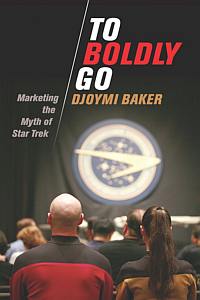The stories, myths, and colossal spheres and regions (and timelines) the Star Trek franchise has generated so far, to a large extend are based on the show’s clever usage and reinterpretation of ancient Greek myths, epic stories of exploration, warfare, politics, and adventure often already familiar to audiences from (classic) storytelling or archaic tales.
 It is the new “look and feel” of the stories that kept fascinating Trekkies for some 60 years and, which in the meantime has made Gene Roddenberry’s Star Trek universe resembling a myth in its own way.
It is the new “look and feel” of the stories that kept fascinating Trekkies for some 60 years and, which in the meantime has made Gene Roddenberry’s Star Trek universe resembling a myth in its own way.
In To Boldly Go author Djoymi Baker, a lecturer of Cinema Studies at RMIT University, Australia, presents her main thesis of how a unique storytelling powers the show. That popular culture, no matter which manifestation of it we have in mind, is based on and actually is fueled by the constant repackaging, recycling and reinterpreting (usually with a new extra feature) its own history.
And thereby in one way referring to the past (where this or that feature originated), but then highlighting that detail in the light of current developments or simply contemporary popular culture. A process, as she proves here constantly, that has been in use repeatedly, be it myth, mythic storytelling, whether epic or brief, that functioned fine for millennia.
Which brings us to the center of the Star Trek universe and Baker’s impression of it, seen through the lens of a never-ending marketing machine and lore recycling unit, its myths and its several reincarnations. As the idea, the story and the mechanisms of it were alive and kicking for many years now, the show’s concept deserves attention (and admiration, one could say).
The story of adventure, exploration, a humanitarian mindset usually colliding with a non-humanitarian universe is repeated again and again Be it in the original show (1966-1969), or a later Roddenberry inspired production from the 1990s, or even the latest Star Trek Blockbuster movie. There, not only the founding myth of the adventures of the ship Enterprise or another Federation vessel is retold repeatedly, but “classic” Star Trek heroes such as Kirk or Spock are being reinvented, rebuilt or reinterpreted.
“In this book I guard that Star Trek is myth, twenty-first-century style: a complex set of stories passed on and updated from one generation to the next, in various media, that have become part of the broader cultural heritage.”
The show and the idea behind it, made Baker connect the very important aspect of its success: the commercial franchise and the countless ways the show’s myth is linked to diverse marketing ideas. Myth and commerce here are united very successful, and her four main chapters explore those regions where few, or rather, no other American shows have gone before.
Depending on what you expect from such a title, the book delivers important aspects of fan culture, the altered concepts of (science fiction) myths, continuity and its counterpart discontinuity or recycling, ancient Greek roots of modern epics and the changing messages and contributions the show in its many variations has provided to changing audiences over time. After all, those topics are closely affiliated with marketing strategies and ideas of consumer loyalty; a show without audiences is not a successful one.
The first section introduces the background of American TV culture of the 1960s, an environment in which Star Trek originally took off in 1966 (and where one early episode actually features Greek mythology and a Greek god). Baker finds evidence that earlier US television shows already introduced old mythology, and a language and pattern for inclusion of such a heritage before Star Trek. Details on Roddenberry’s special treatment of myth are the topic of chapter 2, probably the best section of the book.
Another tremendous impact of the show, apart from shaping and updating classic tales and adventure, lies in the way it has introduced millions of audiences to space exploration, in both hard, scientific ways as well as in philosophical terms; as Starfleet crews usually are conscious of retaining a strong policy of morals and ethics, all based on concepts of humanism and respect. Chapter 3 deals with a blend of such a strategy and cosmology found in the Original Series, The Next Generation, Deep Space Nine, Voyager and Enterprise.
The last section is committed to the Las Vegas Star Trek Experience, a tourist theme attraction park that closed in 2008, which was a three-dimensional manifestation of Roddenberry’s vision. Other manifestations, such as fan-fiction, merchandise and semi-religious forms of admiration for the show are equally researched here.
To Boldly Go is a very usable addition to your shelf with titles on American television shows, the immortal system of storytelling from ancient Greek myths to present day film and shows, science fiction representation and a marketing idea behind all of it that will keep Star Trek vital for several more, still to come reincarnation on screen or whatever media the future holds.
(This review covers the 2023 first paperback edition, the title originally was published in 2018.)
Review by Dr. A. Ebert © 2024
Djoymi Baker. To Boldly Go. Marketing the Myth of Star Trek. Bloomsbury, 2023, 320 p.
